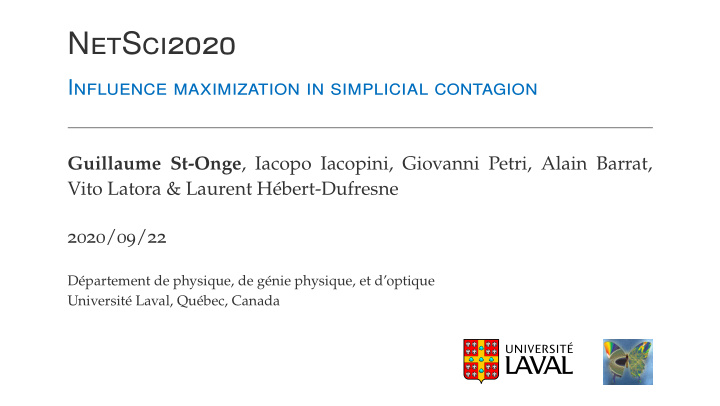



NetSci2020 Influence maximization in simplicial contagion Guillaume St-Onge , Iacopo Iacopini, Giovanni Petri, Alain Barrat, Vito Latora & Laurent Hébert-Dufresne 2020/09/22 Département de physique, de génie physique, et d’optique Université Laval, Québec, Canada
Simplicial contagion (a.k.a simplagion) 1
Mean-field description d I � β ω � k ω � I ω (1 − I ) . d t = − I + w � I ( t ) : fraction of infected nodes � � k ω � : average participation to ω -simplex � β ω : additive infection rate when ω nodes are infected within a simplex N ot appropriate for heterogeneous structures! 2
Some related works � N. Landry, J. G. Restrepo : The effect of heterogeneity on hypergraph contagion models � B. Jhun, M. Jo and B. Kahng : Simplicial SIS model in scale-free uniform hypergraph � J. T. Matamalas, S. Gómez, A. Arenas : Abrupt phase transition of epidemic spreading in simplicial complexes � P. Cisneros-Velarde, F. Bullo : Multi-group SIS epidemics with simplicial and higher-order interactions 3
Key points of the talk 1. An analytical approach to contagions on higher-order networks 2. Dynamical heterogeneity of groups/simplices 3. “ Influential groups/simplices ” can beat “influential spreaders” 4
Who influences Twitter discussions? #myNYPD 1. No correlation between # of followers and influence (retweets+mentions), r = 0 . 145 . 2. Clashes with standard notions of “influential spreaders”. S. Jackson & B. Foucault Welles, Journal of Communication, 2015 5
Who are the influential spreaders of complex contagions on networks with higher-order structure ? 6
Mapping simplagion to complex contagion on bipartite networks 7
Higher-order analytical framework 8
Heterogeneous mean-field equations for nodes Example d s m = 1 − s m − m r s m . d t Approximate master equations for groups d f n,i = µ ( i + 1) f n,i +1 − µi f n,i , d t � � − ( n − i ) β ( n, i ) + ρ f n,i , LHD et al. Phys Rev E, 2010 � � + ( n − i + 1) β ( n, i − 1) + ρ f n,i − 1 . � s m ( t ) : fraction of susceptible nodes with membership m � f n,i ( t ) : fraction of groups of size n with i infected β ( n, i ) , µi : local infection/recovery rates � r ( t ) , ρ ( t ) : mean-field couplings � 9
Simple model of social contagion β ( n, i ) = λi ν � ν < 1 : social inhibition � ν = 1 : SIS model � ν > 1 : social reinforcement 10
Dynamical heterogeneity of groups � Groups of the same size do not all follow the same evolution. � Bimodality of outcomes would be lost in a coarse-grained model. � Can we maximize the faster mode? 11
Influence maximization Goal : Maximize ˙ I (0) by distributing wisely I (0) = ǫ ≪ 1 . Rules � We set λ > λ c so that I ∗ = 0 is unstable � You can choose among two approaches 1. Influential spreaders : engineer node set { s m (0) } 2. Influential simplices : engineer group set { f n,i (0) } � The unchosen set is distributed randomly, i.e. � n � ǫ i (1 − ǫ ) n − i f n,i (0) = or s m = 1 − ǫ ∀ m . i 12
Influential spreaders Influential groups Optimal strategy Optimal strategy Infect nodes with highest Favor most profitable group confi- available membership m gurations ( n, i ) as measured from R ( n, i ) = β ( n, i )( n − i ) /i 13
Influential groups beat influential spreaders in strongly non-linear contagions g m ∼ m − γ m ; p n ∼ θ n e − θ /n ! Influential spreaders 0 . 05 I (0) Influential groups Initial spreading speed ˙ 0 . 04 Random 0 . 03 0 . 02 0 . 01 0 . 00 − 0 . 01 1 . 0 1 . 5 2 . 0 2 . 5 3 . 0 Contagion non-linearity ν 14
What’s next? � The classic picture of influential spreaders sometimes fail. But when? � Understand when to target influential groups or influential spreaders. � Look at the reverse problem : targeted immunization. ◮ Is it better to immunize nodes or parts of groups? � . . . 15
Take-home message 1. We have models to help us think more deeply about the interplay of higher-order structure and non-linear contagions 2. These models shift the focus from individuals to groups 3. Influential groups/simplices vs influential spreaders/nodes 16
Aknowledgments Thanks to my collaborators Iacopo Iacopini, Giovanni Petri, Alain Barrat, Vito Latora, Laurent Hébert-Dufresne Preprints using the same framework arXiv:2004.10203 and arXiv:2003.05924 Funding and computational ressources 17
Recommend
More recommend